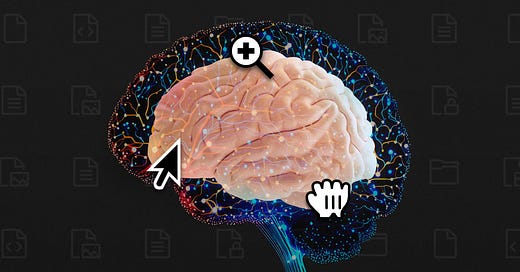Contrary Research Rundown #36
Our latest deep dive on building an AI-powered second brain, and new memos on GOAT, Turo and more
From Notetaking To Neuralink: The AI-Powered Second Brain
Since the beginning of the internet and the proliferation of social media, people have been increasingly bombarded with news, articles, and data, all competing for finite attention. Information overload and digital clutter can prove overwhelming and limit people’s ability to think clearly and creatively.
The human brain, although an incredible tool for generating ideas and solving complex problems, is ill-equipped to manage such a deluge of data. As a result, it often struggles to retain and make sense of overabundant information. The volume of information is reaching such a volume that just being selective about what you consume is no longer an effective solution. At such great velocities of new information, distinguishing signal from noise is becoming an impossible task for any unaided human mind.
Traditional approaches to information retrieval tend to be static. We have to tag, link, and update our knowledge base ourselves. The hardest part is finding your insights on demand. Search is a useful tool but relies on one thing we want to escape: the limits of the human mind. It’s up to us to recall the information we want to retrieve (from our second brain), find it, and implement it.
By contrast, an AI-powered second brain would enable dynamic retrieval, adapting to the user's needs and presenting relevant information based on context and current tasks. Coveo, the AI-powered enterprise search tool, showed that knowledge workers spend an average of 3.6 hours searching for information each day, highlighting the inefficiency of conventional methods. By employing dynamic retrieval, the time spent on information search can be dramatically reduced, allowing knowledge workers to devote more energy to creative problem-solving.
For more on the evolution of personal learning, knowledge management, and the implications of AI, check out our latest deep dive by Alex Banks.
Zip provides a platform for the end-to-end procurement lifecycle, covering new purchase order management, accounts payable automation, and global B2B payments. To learn more, read our full memo here.
Neo Financial is a digital banking platform that wants to simplify spending, savings, borrowing, and investing for Canadians. To learn more, read our full memo here.
GOAT Group is a holding company that houses 4 luxury fashion platforms — GOAT, alias, Flight Club, and Grailed — for sales of sneakers, streetwear, apparel, and accessories. To learn more, read our full memo here.
Statsig is a platform that enables companies to run rapid product experiments and analyze how users respond to new features. To learn more, read our full memo here.
Turo is a car-sharing marketplace that allows car owners to rent out their vehicles when not in use, increasing the utilization of vehicles by unlocking latent supply while providing a new source of income for car owners. To learn more, read our full memo here.
Blizzard’s chief design officer told employees to “prepare to be amazed” by the company’s AI image generator trained on assets from its games.
OpenAI CEO Sam Altman, President Greg Brockman, and Chief Scientist Ilya Sutskever say the world will likely need a regulatory body for superintelligence.
Meta unveiled open-source AI models the company says can identify 4,000+ languages and produce speech for 1,000+ languages.
The Supreme Court ruled that Google and Twitter were not responsible for helping foster terrorist attacks through content recommendations.
Apple banned employees from using ChatGPT, Copilot, and other AI tools to avoid leaking confidential information while developing its generative AI system.
Earlier this week, Google competitor Neeva said it is shutting down its consumer search engine to focus on enterprise efforts. Just a few days later, Snowflake announced it would acquire the company to build up more intelligent search.
Adobe launched Generative Fill for Photoshop, one of the first Creative Cloud apps to use its generative AI Firefly tool, in beta, rolling out fully in H2 2023. Adobe said the product would let users extend images and add or remove objects in the frame using text prompts.
Shutterstock plans to acquire Giphy from Meta for $53M in cash after the UK CMA blocked Meta’s acquisition in 2022; Meta can still access Giphy content.
An interview with Microsoft CTO Kevin Scott as the company adds OpenAI-powered Copilots to everything from Office to Edge to the Windows Terminal.
Anthropic, a generative AI startup co-founded by OpenAI veterans, raised a $450M Series C led by Spark Capital.
Google CEO Sundar Pichai called AI the “most profound” technology humanity is working on today and called for responsible development.
Google announced Project Studio, a free generative AI tool for merchants to edit product images by replacing background scenes or improving resolution.
Spotify is building AI tools trained on its hosts’ voices to create targeted ads, per Bill Simmons, the founder of the Spotify-owned podcast network The Ringer.
OpenAI plans to use Bing as the default search experience for ChatGPT, starting on May 23 for ChatGPT Plus users and soon for free users via a ChatGPT plugin.
Google plans to use generative AI to boost the relevance of Search ads based on query context and debuts a conversational experience for creating ads.
Netflix cracks down on password sharing in the US and offers paid sharing, which lets some accounts add an extra member outside their household.
A profile of Microsoft President Brad Smith, a DC veteran pushing to shape AI regulation, including by proposing a new agency, testing a well-worn playbook.
OpenAI CEO Sam Altman recently visited London as part of a tour to 17 cities, including Paris, Warsaw, and Lagos, to discuss AI, balanced regulation, and more.
Google DeepMind showed how its visual language model Flamingo is generating descriptions for YouTube Shorts based on metadata.
TikTok is testing chatbot Tako in select markets; the bot appears on the right side of the app and lets users ask questions about a video or finding new content











